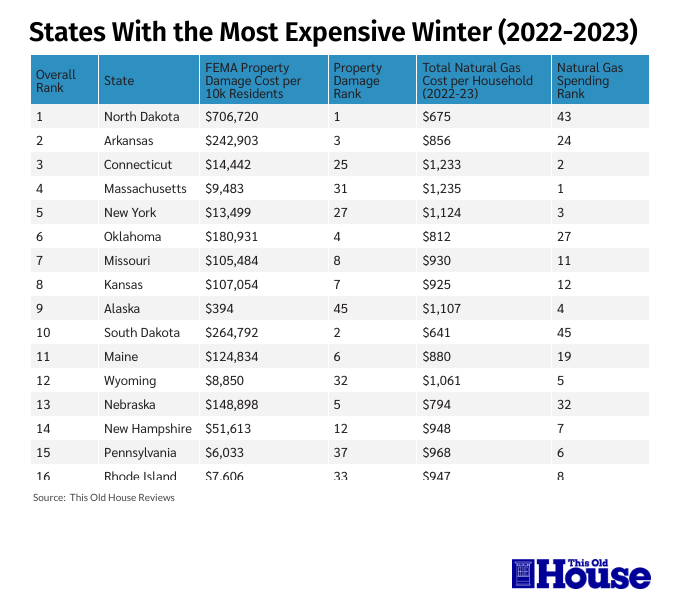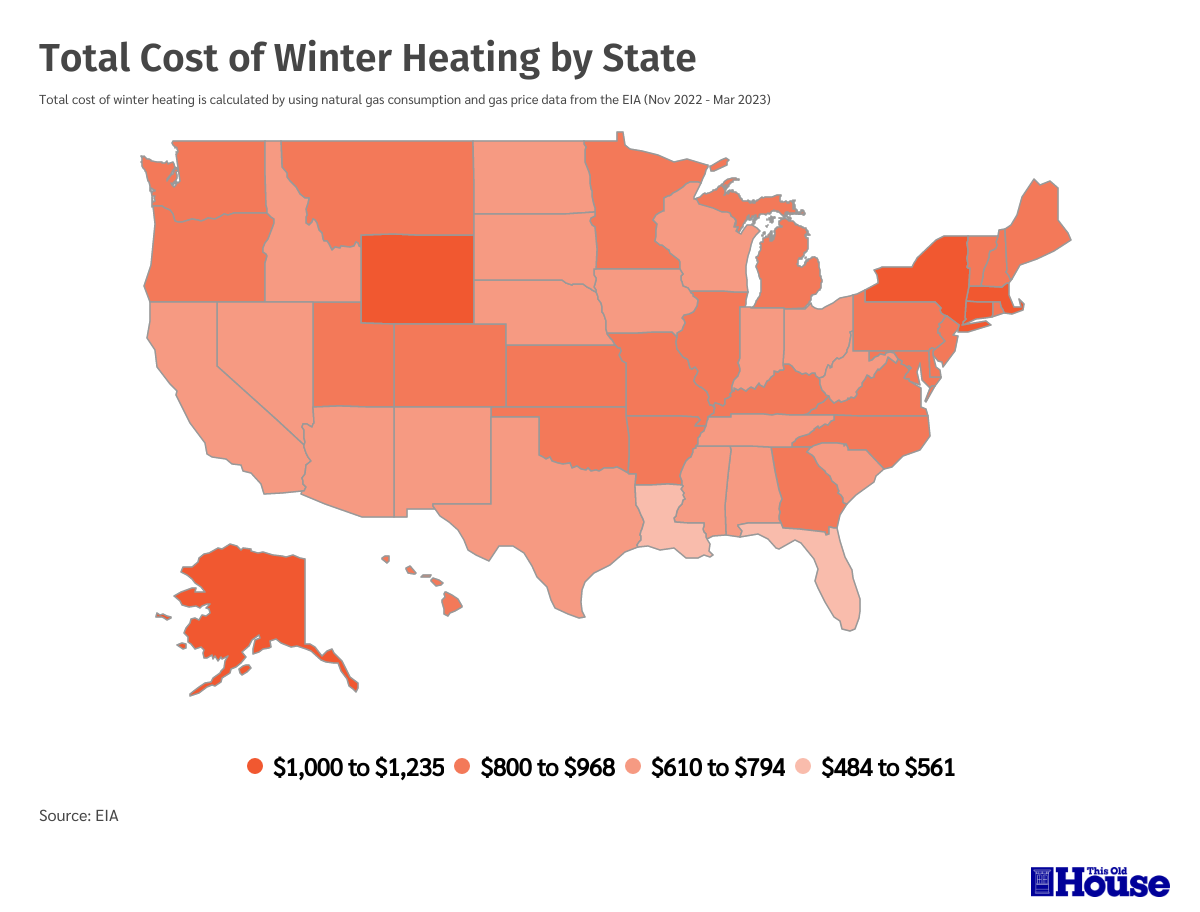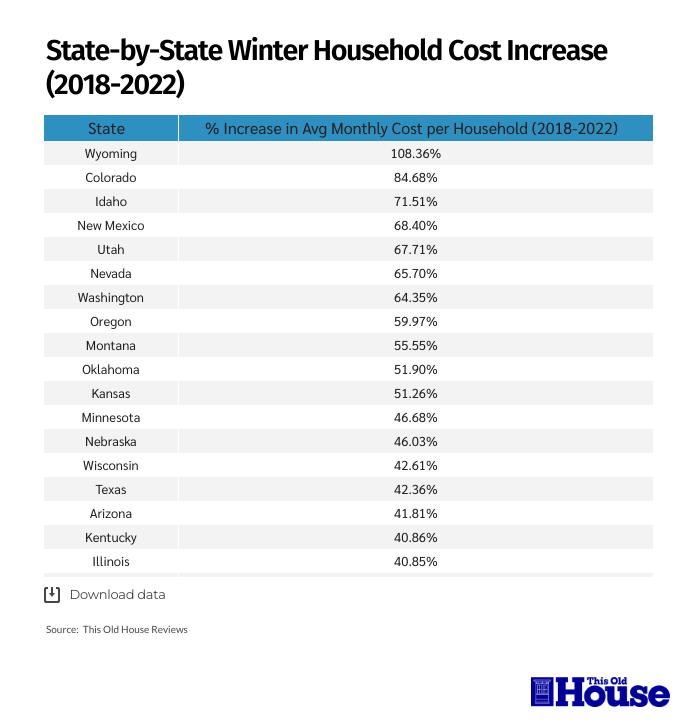
Which states spend the most in winter?
As temperatures dip after the hottest summer on record, many homeowners look forward to hot cocoa, snowy evenings by the fireplace, and holiday visits with family. However, despite its joys, winter is often the most expensive season of the year—and not just because of holiday shopping.
While the U.S. Energy Information Administration (EIA) expects the roughly 46% of Americans who use natural gas to heat their homes to spend the same or less this winter than they did last year, households that use electricity, propane, or heating oil will see significant increases.
The 2022-23 winter season also saw steep energy cost inclines from the year before. Last August, electricity prices had already jumped 15.8% from the previous year, and there was an estimated increase of 17.2% for winter heating costs. Drivers included a 6.5% year-end headline inflation rate, overseas conflicts that led to rising oil and gas prices, and high labor and maintenance costs to repair aging electrical grids.
To better understand where homeowners pay the most, the This Old House Reviews Team analyzed data from the EIA and the Federal Emergency Management Agency (FEMA) to determine average heating costs and winter property damage spending in each U.S. state.
Key findings
- The average household spent $855 to heat its home using natural gas during the 2022-23 winter season.
- North Dakota had the most expensive winter when combining average winter heating costs and property damage spending.
- Last year, households in Massachusetts had the highest winter heating costs for natural gas at $1,235.
- Natural gas prices increased by 53% in 2022-23 from the previous season.
- Over the past five years, natural gas price increases of 20% are the norm for 35 out of 50 states.

States with the most expensive winters, ranked
This study ranked the states that have had the most expensive winters, both in terms of heating costs for the season and potential property damage costs from winter weather events. To determine winter costs for each state, natural gas consumption and gas prices in each state were examined along with data from FEMA that showed the cost of winter property damage in each state per 10,000 residents.
Natural gas prices fluctuate due to several factors, but last winter, the average cost of natural gas in the United States was the highest it had been since 2008, with a 53% increase from 2021 to 2022. As a result, nationwide, the average household spent $855 in home heating costs last winter.
But heating isn't the only winter-related cost homeowners have to contend with. Our team also looked at the amount of property damage that winter events, such as snow and ice storms, can cause. North Dakota ranked No. 1 for costliest winter, primarily due to property damage; according to data from FEMA, repairing winter weather damage cost the state an average of $706,720 per 10,000 residents.

Average winter heating costs by state
Aside from property damage, this study examined average winter heating costs in each state. For this aspect specifically, natural gas consumption and price data from the EIA was analyzed and compared to Census data to determine actual household costs.
Massachusetts had the highest winter heating costs, with each household spending an average of $1,235 on natural gas in the 2022-23 season. The states with the highest natural gas heating costs were in the northeast, with Connecticut trailing closely behind Massachusetts at $1,233 per household and New York in third place at $1,124 per household. Most other states paid less than $1,000 per household on heat, with the exceptions of Alaska ($1,107) and Wyoming ($1,061).
States with mild winters generally have relatively low natural gas consumption, with Florida spending the least at $484 per household for the season. Hawaii, despite its lack of cold winters, averaged $930 in natural gas consumption per household, and its electricity costs are among the highest in the nation. According to the EIA, Hawaii's electricity costs are triple the U.S. average because the state uses a lot of petroleum, and each island has its own electrical grid.

States with the highest winter heating price increases
So, where do we see the greatest increase in winter heating prices? Although the states with the highest heating costs are in the northeast, the western United States—which has the most widespread use of natural gas for heating—saw the biggest price increases.
In Wyoming, heating prices increased by more than 108% from 2018 to 2022. Of the remaining top 10 states with the greatest winter heating price increases during this five-year period, nine of them were Western states, including Colorado (85% increase) and Idaho (72% increase).
Winter costs per household actually decreased in some parts of the country. Although Hawaii's average energy costs are high overall, prices fell by nearly 7% from 2018 to 2022. Rhode Island's natural gas costs dropped by almost 5.5%, while Florida's dropped by 4.6%. Unfortunately, price increases of 20% or more from 2018 to 2023 were the norm for 35 out of 50 states.
How to prepare for winter
All homeowners, regardless of where they live, can take steps to better prepare for winter and guard against property damage. Fall is a good time to clean out gutters, check for roof leaks, and have a professional inspect heating systems to ensure their safety and good working order. Protecting pipes in cold weather helps prevent them from freezing and bursting. Fireplaces and chimneys should be cleaned each season, and homeowners should regularly inspect batteries in smoke and carbon monoxide detectors.
With winter heating costs higher than ever, having a home warranty plan can help make repairs to an HVAC or furnace more affordable. The government's Low Income Home Energy Assistance Program (LIHEAP) can help those who are unable to afford the rising costs of heating or necessary home repairs to winterize their homes.
To counter the high costs of utilities, check to see if your local utility company offers free energy checks to determine where your home could be more efficient. Ensuring your home is well insulated and that all cracks are sealed is important to avoid heat loss. Upgrading to better-insulated windows can help keep the cold out, and this list of the best window brands offers suggestions for financing and discounts as well as energy efficiency.
Methodology
The This Old House Reviews team used natural gas price and consumption data from the U.S. Energy Information Administration (EIA) and winter weather building damage estimates from the Federal Emergency Management Agency (FEMA) to assess winter weather costs for each state. We ranked each state across two metrics:
- Total winter cost (natural gas) per household: This is how much the average household in each state spent to heat their home with natural gas from November 2022 through March 2023. Data on residential natural gas costs and usage comes from the EIA. To calculate per-household heating costs, we used data on household natural gas usage by state from the U.S. Census.
- Total annual building damage costs per 10,000 residents: This is the estimated building damage cost due to winter weather, cold wave, and ice storm damage per 10,000 residents. Data on building damage costs comes from FEMA's National Risk Index data. To determine the cost per 10,000 residents, we used population data from the U.S. Census.
This story was produced by This Old House Reviews Team and reviewed and distributed by Stacker Media.



